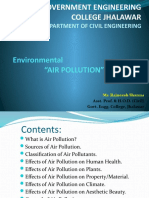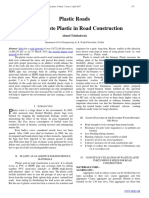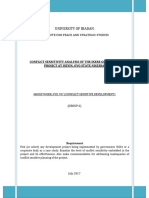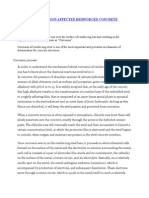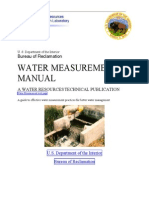Air Quality:: Definitions, Characteristics, and Perspectives
Air Quality:: Definitions, Characteristics, and Perspectives
Uploaded by
^nana^Copyright:
Available Formats
Air Quality:: Definitions, Characteristics, and Perspectives
Air Quality:: Definitions, Characteristics, and Perspectives
Uploaded by
^nana^Original Description:
Original Title
Copyright
Available Formats
Share this document
Did you find this document useful?
Is this content inappropriate?
Copyright:
Available Formats
Air Quality:: Definitions, Characteristics, and Perspectives
Air Quality:: Definitions, Characteristics, and Perspectives
Uploaded by
^nana^Copyright:
Available Formats
AIR QUALITY :
DEFINITIONS, CHARACTERISTICS, AND
PERSPECTIVES
CONTENT
Definitions
Unit Measurement
Source of Pollutants
Classification of Pollutants
Particulates
Hydrocarbons
CO
Oxides of Sulfur
Oxides of Nitrogen
Photochemical Oxidants
Indoor Air Pollution
Global Implications of Air Pollution
AIR POLLUTION
Presence in the outdoor atmosphere of one or more air contaminant (i.e dust,
fumes, gas, mist, odor, smoke or vapor) in sufficient quantities, of such
characteristics and of such duration as to be or to threaten to be injuries to
human, plant or animal life or to property or which reasonably interferes the
comfortable enjoyment of life or property
DEFINITION
Suspended particulates- mass per unit volume basis (g/m
3
)
Gaseous contaminants ppm/ppb
For gases, ppm convert to g/m
3
mol L
x mass gmol x ppm
m
g
/
10
3
3
Standard condition for many chemical reaction:
T1 = 273 K (0C)
P1 = 1 atm (760 mmHg)
V1 = 22.4 L/mol
While T2,P2,V2 relate to actual conditions being considered.
*But most air quality determinations are referenced at 25C, 760 mmHg
2
2 2
1
1 1
T
V P
T
V P
UNIT MEASUREMENT
SOURCE OF POLLUTANTS
Natural sources
Fungi spores, salt spray, smoke from contaminant,
dust particles from forest fires and volcanic
eruptions
CO from the breakdown of methane
Hydrocarbons from pine trees
H2S and CH4 from the anaerobic decomposition of
organic matter
SOURCE OF POLLUTANTS CONTD
Mobile transportation
Stationary combustion
Industrial processes
Solid-waste disposal
SOURCE OF POLLUTANTS CONTD
Mobile transportation
Stationary combustion
Residential
Commercial
Industrial power and
heating including
steam-powered electric
power plant
SOURCE OF POLLUTANTS CONTD
SOURCE OF POLLUTANTS CONTD
Industrial Processes
Chemical
Metallurgical
Pulp-paper industries
Petroleum refineries
SOURCE OF POLLUTANTS CONTD
Solid waste Disposal
Household
Commercial refuse
Coal refuse
Agricultural burning
CLASSIFICATION OF POLLUTANT
Origin
Considered as primary or secondary
contaminants
Primary found in the form of which omitted
(SOx, NOx and HC)
Secondary formed in atm by photochemical
reaction or hydrolysis or oxidation (ozone &
peroxyacetyl nitrate (PAN) )
CLASSIFICATION OF POLLUTANT CONT
Chemical composition
Organic or inorganic
Organic contain C, H and other elements such as
O2, N2, Ph & S, carboxylic acids, alcohols, ethers,
esters, amines etc
Inorganic CO, CO2, carbonates, SO, NO, ozone,
HF, HCl
State of matter
Either particulate or gaseous
Particulate dust, fumes, smoke, fly ash
Gaseous behave much as air, CO, SO, NO, HC
CLASSIFICATION OF
POLLUTANTS
Oxides of sulphur
Carbon monoxide
Hydrocarbon
Particulate
Indoor Air Pollution
Oxides of nitrogen
Photochemical
oxidants
PARTICULATES
Identified as any dispersed matter, solid or
liquid, in which the individual aggregates are
<500m but larger than small molecule
3 classification physical, chemical or
biological
PHYSICAL CHARACTERISTICS
Size
Particle of major interest in air pollution studies range from 0.01 to
100 micron
Ex: metallurgical fumes, cement dust, fly ash, carbon black,
sulfuric acid mist, smoke
Mode of formation
Dust
-small, solid particles
-created by the breakup of larger masses through processes such
as crushing, grinding or blast
-may come directly from the processing or handling or materials
such as coal, cement or grains
-by product of mechanical process sawing of wood
-residue of mechanical operation sandblasting
-do not diffuse settle by gravity
-diameter range-1.0 to 10000 micron
Smoke
-fine, solid particles
-resulting from the incomplete combustion of organic
particles coal, wood or tobacco
-consist of mainly C & combustible materials
-diameter range 0.5 to 1 micron
Fumes
-Fine, solid particles
-Formed by the condensation of vapors of solid material
-May come from sublimation, distillation, calcination or
molten metal processes
-Diameter range 0.03 to 0.3 micron
-Flocculate and coalesce settle out
Fly ash
-Finely divided, noncombustible particles
-Contained in flue gases from combustion of coal
-Particles range 1.0 to 1000 micron like dust
-Results from burning like smoke
-Consist of inorganic metallic or mineral substances like fumes
Mist
-Liquid particles or droplets
-Formed by the condensation of a vapor, dispersion of liq or
enactment of chemical reaction
-Less than 10 micron in diameter
-High conc of mist -fog
Spray
-Liquid particles
-Formed by the atomization of parent liquids, such as
pesticides and herbicides
-Particle range 10 to 1000 micron in diameter
Settling properties
Is the major natural self-cleansing process
Suspended particulates size less than 1 to
20 micron
Settleable particulates larger than 10
micron
18
) (
2
p w p
t
d g
v
Optical qualities
Cause reduction in visibility
Affected by particles in range of visible light
(0.38 to 0.76 micron)
Affected by particle shape, surface
characteristics, distribution of particles
Chemical characteristics
Contain both organic and inorganic components
Organic phenols, organic acids, alcohols
Inorganic nitrates, sulfates, metals (iron, lead,
manganese, zinc and vanadium)
Biological characteristics
Include protozoa, bacteria, viruses, fungi,
spores, pollens and algae
Microorganisms survive for short time in atm
lack of nutrients and ultraviolet radiation
from sun
Certain bacteria and fungi can survive for
long periods
Effect of particulates
On human health
At high conc, poses hazards to those susceptible to
respiratory illness
Human respiratory system defend itself against
invasion of foreign substances as indicated in Table
7-8 pg 437
The success or failure of respiratory defense
system depends on size of particulates inhaled and
depth of penetration
40% of 1 - 2 micron particles retain in bronchioles
and alveoli
0.25 to 1 micron breathed in and out
Particles below 0.25 micron results in
impingement
Lead
Human exposure originate from inhalation and
ingestion of lead containing particulates
Affect reproductive, endocrine, hepatic etc
Acute lead poisoning-vomiting, colic, insomnia,
irritability
Chronic lead poisoning headache, weakness
Aeroallergens
-Refer to airborne substances causing allergies
-Common allergens pollen and spores
-Others of biological origin yeasts, molds, animal fur,
feathers and hair
Effects on Plants and animals
Little damage if deposited on a leaf surface
Reduce photosynthesis, hence plant growth
Effects on Materials
Soiling clothing and textiles
Corroding metals (at RH above 75%)
Eroding building surfaces
Discoloring and destroying painted surfaces
Organic compounds containing C and H only
Aliphatic hydrocarbon:
Alkanes: saturated HC ( ex: methane), generally not active in
atmospheric photochemical reaction
Alkenes/olefins : unsaturated, highly reactive in atmospheric
photochemistry
Alkynes : highly reactive, rare, not major concern
Aromatic HC
Biochemically and biologically active
Some are potentially carcinogenic
Concern ~ polynuclear group of aromatic HC because some of these
compounds have been shown to be carcinogenic ~ lung cancer
Sources
-Natural
Biological sources
Geothermal areas
Coal fields
NG from petroleum fields
Natural fires
Plants & trees
-Anthropogenic
Industrial sources
Transportation
Solid waste disposal
Forest fires
etc
HYDROCARBON
CARBON MONOXIDE
Colourless, tasteless, odourless
If high concentration ~ affect human,
vegetation & material
Refer to table 7.11 page 445
Sources
Natural ~ vegetation decay
~ human metabolism ( a resting person-
1 ppm CO)
Anthropogenic ~ transportation
~ fuel combustion in stationary
sources
~ industrial processes
~solid waste disposal
SO
X
(OXIDE OF SULPHUR)
6 gaseous compounds
Sulphur monoxide (SO)
Sulphur dioxide (SO
2
)
Sulphur trioxide (SO
3
)
Sulphur tetraoxide (SO
4
)
Sulphur sesquioxide (S
2
O
3
)
Sulphur heptoxide (S
2
O
7
)
SO
2
Colourless, nonflammable, nonexplosive, suffocating odour,
stable in athmosphere, highly soluble in water
Source: Oil & gas industry, energy production, coal burning,
industrial combustion & industrial processes
Effect : Human: aggravates asthmatic & bronchitis
Plants: damage vegetation
Transport~1000 km
NO
X
( OXIDES OF NITROGEN)
6 gaseous compounds
Nitric oxide ( NO)
Nitrogen dioxide ( NO
2
)
Nitrous oxide ( N
2
O)
Nitrogen sesquioxide ( N
2
O
3
)
Nitrogen tetroxide ( N
2
O
4
)
Nitrogen pentoxide ( N
2
O
5
)
NO
2
Cause respiratory illness
Source Transport, power generation & industrial
combustion
Readily soluble in water~ nitrous acid or nitric oxide
PHOTOCHEMICAL OXIDANTS
Photochemical oxidants indicate the net oxidizing ability of
ambient air
0
3
, 0, 0
2
, PAN, PPN, H
2
O
2
eg f oxidants
Effects of Oxidants
On human health coughing, shortness of breath, airway constriction,
heachace etc, exposure to high level of ozone result to damage chromosomes
Effects of plants major oxidant cause damage to plant is O3 and PAN as
both enter the plan leaf thru stomata and intefere plant cell metabolism,
exposure level of 0.01 0.15 ppm will reduce crop yeilds (soybeans, corn,
radishes)
Effects on materials O3 oxidizes paint, elastomers, textile fibres and dyes
Source of oxidants
Produced in upper atmosphere by solar radiation, lightning and forest fires
INDOOR AIR POLLUTION
Originated from building materials,
furnishings, equipment and such human
activities as cooking, cleaning and smoking
SUMMARY OF DETECTIONS AND STANDARD &
CONTROL
Pollutants Source Detections Standard & Control
Hydrocarbon :
Aliphatic HC
(contain
alkanes,
alkenes and
alkynes) and
Aromatic HC
-Natural source are
from biological sources
plant and tree
-Anthropogenic
industrial refineries,
transportation
Gas chromatography S-160 g/m
3
C-
incineration,adsorption,
absorption,
condensation
Carbon
monoxide
Decaying vegetation-
oxidation of methane
-human metabolism
-transportation,solid-
waste disposal, forest
fires
Nondispersiveinfrared
(NDIR), gas
chromatography,
catalytic conversion,
flame ionization
detection
S-10 mg/m
3
(8 hr)and 40
mg/m
3
(1 hr)
C-adsorption, abs,
condensation,
combustion
Oxides of sulfur
SO2 and SO3
Burning of solid and
fossil fuel, industrial
processes
Colorimetric,
conductometric,
coulometric,
spectroscopic
S-6 to 10 g/m
3
for 24 hr
average
C-burning fuel with less
sulfur, dispersion by tall
stacks, remove sulfur
from fuel
-
SUMMARY OF DETECTIONS AND STANDARD &
CONTROL
Pollutants Source Detections Standard &
Control
Oxides of nitrogen
NO and NO2
-Natural source are
solar radiation,
lightning
-Anthropogenic
fuel combustion,
transportation
Calorimetric method,
ultraviolet
spectrophotometry,
electrical tranducers
S-100 g/m
3
C-modification
of combustion
conditions,
devices to
remove NOX
from exhaust
Photochemical
oxidants ozone,
PAN, H2O2
Solar radiation,
lightning
-,ultraviolet
photometry
-gas chromatography
(PAN)
S-240 g/m
3
(1hr)and 40
mg/m
3
(1 hr)
GLOBAL IMPLICATION OF AIR POLLUTION
-Results gaseous emissions of sulfur oxides (SO
x
) and nitrogen oxides
(NO
X
) + water vapour + sunlight strong acidic
compounds
(i.e H
2
SO
4
& HNO
3
)
- H
2
SO
4
& HNO
3
+ other organic & inorganic chemicals are deposited on
the earth as:
i) Dry deposition : aerosol & particulates
ii)Wet deposition: raindrops, snowflakes , fog or dew
-Effect of acid rain deposit vary
i) sensitivity of ecosystem
ii) damage to building & monuments in highly industrialized areas
O
3
reduces UV radiation that reaches earths surface
O
3
layer deplete from O
3
reaction with Cl
2
- CFC (use as
aerosol spray propellants)
Industrialized nation banned the use of fluoroC
CO
2
increase O
2
decreases
Increase in CO
2
:
Fossil fuel consumption
Agricultural
Forestry
Land use practices
Continued build up melt Artic ice pack
Cold countries ~a green house usually built a glass~ used to grow
plants & flowers that require plenty of warmth
Sunshine thru glass ~ inside of the greenhouse( very warm)~ roof
and walls keep heat from escaping
Earths T increase even 1C experience change in :
Weather patterns
Flooding
Rising sea-level
Glaciers melt
But industrial gases i.e CO2, CH4, Nox, CFC ~ trap a certain kind of
radiation ( infrared) ~ heat ~ keep it close to earths surface
Malaysian Air Pollution Index (MAPI) ~ measures level of criteria air pollution
May occur as a result of :
Natural causes
Mans activities
Natural pollutants:
Soil dust
Volcanic eruption
Salt splashes from the sea
Man made pollutants:
Smoke & wastes from fuel burning
Wastes from industrial processes
HC from combustion processes
Normal local & foreign sources:
Motor vehicles
Industrial operation
Open burning
Land clearing & construction
Deforestation
Ashes from volcanic eruption
You might also like
- Environmental Science Reviewer.Document8 pagesEnvironmental Science Reviewer.Althea Mae JarinaNo ratings yet
- Meteorology and Natural Purification Processes1Document43 pagesMeteorology and Natural Purification Processes1^nana^100% (2)
- 1) Fire Fighting Drawing (Mechanical & Electrical)Document26 pages1) Fire Fighting Drawing (Mechanical & Electrical)BhushanNo ratings yet
- Characterisation of Pollutants Sources of PollutantsDocument15 pagesCharacterisation of Pollutants Sources of PollutantsRohan ChauguleNo ratings yet
- Air Pollution For Environmental ScienceDocument25 pagesAir Pollution For Environmental Scienceobaid kuraishyNo ratings yet
- Air Pollution: by Bibhabasu MohantyDocument54 pagesAir Pollution: by Bibhabasu MohantyJaned PerwiraNo ratings yet
- Thermal Power Engineering: Environmental Aspects of Power GenerationDocument86 pagesThermal Power Engineering: Environmental Aspects of Power GenerationArul SankaranNo ratings yet
- Unit 2 - PollutionDocument211 pagesUnit 2 - PollutionJayashreeNo ratings yet
- Environmentalandnutritionaldiseases POMDocument87 pagesEnvironmentalandnutritionaldiseases POMYzsa Geal InalNo ratings yet
- Unit 2 - PollutionDocument232 pagesUnit 2 - PollutionHariharan MNo ratings yet
- Air Pollution: Adriana Agovska, MD, PHD Department of Hygiene, Medical Ecology and Nutrition, SofiaDocument51 pagesAir Pollution: Adriana Agovska, MD, PHD Department of Hygiene, Medical Ecology and Nutrition, SofiaTasos ZelevarisNo ratings yet
- 1 Air PolutionDocument29 pages1 Air PolutionganeshsambhangiNo ratings yet
- IGNTU Econtent 674613883400 B.SC EnvironmentalSciences 2 PallaviDas EnvironmentalPollutionandHumanHealth 2Document136 pagesIGNTU Econtent 674613883400 B.SC EnvironmentalSciences 2 PallaviDas EnvironmentalPollutionandHumanHealth 2Neeraj Raushan KanthNo ratings yet
- Air Pollution - Sources, Effects & ManagementDocument45 pagesAir Pollution - Sources, Effects & ManagementSrijaJuluruNo ratings yet
- Air PollutionDocument97 pagesAir PollutionPMNo ratings yet
- Envi Engg Topic 5 NotesDocument6 pagesEnvi Engg Topic 5 Noteslesleles304No ratings yet
- Unit - III PollutionDocument88 pagesUnit - III PollutionPurna BhavnariNo ratings yet
- Lecture 6 Environmental-Pollution-2 PDFDocument69 pagesLecture 6 Environmental-Pollution-2 PDFbholaNo ratings yet
- Environmental Aspects of Power Generation: (Produced by Biomass)Document55 pagesEnvironmental Aspects of Power Generation: (Produced by Biomass)Arul SankaranNo ratings yet
- Pollution and Its ControlDocument21 pagesPollution and Its ControlPriya TikadarNo ratings yet
- L 3Document48 pagesL 3Desbelom Welegebrial HagosNo ratings yet
- Air Pollution: by Bibhabasu MohantyDocument54 pagesAir Pollution: by Bibhabasu Mohantyarun aryaNo ratings yet
- Lecture 6 Environmental-PollutionDocument71 pagesLecture 6 Environmental-PollutionD V MaskarNo ratings yet
- Airpollution 150408115822 Conversion Gate01 (1)Document20 pagesAirpollution 150408115822 Conversion Gate01 (1)SaadNo ratings yet
- airpollution-150408115822-conversion-gate01Document20 pagesairpollution-150408115822-conversion-gate01SaadNo ratings yet
- 4158 Alia 1 Metode SamplingDocument71 pages4158 Alia 1 Metode SamplingoliviaNo ratings yet
- Lecture 6 Environmental-PollutionDocument70 pagesLecture 6 Environmental-PollutionPandurang Pisal100% (1)
- Air PollutionDocument68 pagesAir PollutionjohnnyNo ratings yet
- Ilovepdf - Merged 1 1Document105 pagesIlovepdf - Merged 1 1pratik kmrNo ratings yet
- Environmental PollutionDocument54 pagesEnvironmental PollutionAman ShrivastavaNo ratings yet
- PollutionDocument52 pagesPollutionSoham MukherjeeNo ratings yet
- IAQ NotesDocument10 pagesIAQ NotesChunkit LamNo ratings yet
- Air Pollution L2-3Document4 pagesAir Pollution L2-3hariomsingh60357No ratings yet
- EvsDocument79 pagesEvsMOHD FAHEEMNo ratings yet
- 21CIV57-Module 3Document24 pages21CIV57-Module 3LINIJA SHYLIN KPNo ratings yet
- Air Pollution PT 1Document26 pagesAir Pollution PT 1rajneesh101318100% (1)
- Air Pollution SourcesDocument25 pagesAir Pollution Sourcesanjaneya mishraNo ratings yet
- Unit I - IntroductionDocument34 pagesUnit I - Introductionutvpkd.broadbandNo ratings yet
- Air PollutionDocument22 pagesAir PollutiondlprojectvideosecgNo ratings yet
- Air Pollution 1Document22 pagesAir Pollution 1padokis962No ratings yet
- Vnd.openxmlformats Officedocument.presentationml.presentation&Rendition=1 5Document59 pagesVnd.openxmlformats Officedocument.presentationml.presentation&Rendition=1 5princerao2072006No ratings yet
- Environment & EcologyDocument10 pagesEnvironment & EcologySRIKANT KUMAR NAYAKNo ratings yet
- Module 2 PollutionDocument17 pagesModule 2 Pollutionmcd83773No ratings yet
- Audit Course SEAI&ML PanuuDocument17 pagesAudit Course SEAI&ML PanuuPranu LondheNo ratings yet
- Air Quality, Pollution and ControlDocument5 pagesAir Quality, Pollution and ControlSilvers RayleighNo ratings yet
- Air Pollution and Air Pollution ManagementDocument39 pagesAir Pollution and Air Pollution ManagementGabs ZarellaNo ratings yet
- Air Quality Engineering 3Document77 pagesAir Quality Engineering 3Raven ReiiNo ratings yet
- Natural Sources and Artificial SourcesDocument4 pagesNatural Sources and Artificial SourcesMalikNo ratings yet
- Air Pollution Occurs When Harmful SubstancesDocument9 pagesAir Pollution Occurs When Harmful SubstancesSourav Kumar GuptaNo ratings yet
- Air PollutionDocument22 pagesAir PollutionImogen YstNo ratings yet
- Chapter 3 - Air PollutionDocument28 pagesChapter 3 - Air PollutionKamarul NizamNo ratings yet
- Environmental Pollution-Causes, Effects and Control MeasuresDocument89 pagesEnvironmental Pollution-Causes, Effects and Control Measuresshree devNo ratings yet
- Lec 28Document54 pagesLec 28ANANDNo ratings yet
- Chapter 3-Air Pollution (Notes)Document164 pagesChapter 3-Air Pollution (Notes)TzipporahNo ratings yet
- Air Quality ManagementDocument21 pagesAir Quality ManagementLim KElvinNo ratings yet
- Q4 Long Test Reviewer EnviDocument5 pagesQ4 Long Test Reviewer EnviAlma TatelNo ratings yet
- ES unit -3Document99 pagesES unit -3kupendar.civilNo ratings yet
- Air Pollution Lect.1Document277 pagesAir Pollution Lect.1Nah Sr AdNo ratings yet
- EVS 2022 PPT Unit 3Document59 pagesEVS 2022 PPT Unit 3z42c4dcrkcNo ratings yet
- Air Pollution 2024 2023 MBBSDocument43 pagesAir Pollution 2024 2023 MBBSALok AcharyaNo ratings yet
- The Natural vs. Human Causes of Air Pollution : Environment Textbooks | Children's Environment BooksFrom EverandThe Natural vs. Human Causes of Air Pollution : Environment Textbooks | Children's Environment BooksRating: 4 out of 5 stars4/5 (1)
- Antibiotic Usage For Selection of Resistant E. Coli CellsDocument1 pageAntibiotic Usage For Selection of Resistant E. Coli Cells^nana^No ratings yet
- Solid Waste (Compatibility Mode)Document6 pagesSolid Waste (Compatibility Mode)^nana^No ratings yet
- Water Treatment ProcessesDocument30 pagesWater Treatment Processes^nana^No ratings yet
- Biofuels in MalaysiaDocument40 pagesBiofuels in Malaysia^nana^No ratings yet
- Research Compilation PlanningDocument4 pagesResearch Compilation Planningchengliii.luluNo ratings yet
- Trial Transcript 2009-04-30 PMDocument162 pagesTrial Transcript 2009-04-30 PMKatrinaDocsNo ratings yet
- Chloride Attack On Stainless SteelDocument10 pagesChloride Attack On Stainless SteelgovimanoNo ratings yet
- Water Framework DirectiveDocument4 pagesWater Framework DirectiveMilorad Zjalić100% (1)
- Modeling of Gas Turbine Based Cogeneration System (2012)Document8 pagesModeling of Gas Turbine Based Cogeneration System (2012)Dominic angelNo ratings yet
- Municipality of Labrador HistoryDocument5 pagesMunicipality of Labrador HistorypaulNo ratings yet
- Thiet Ke Nut Ham Tham KhaoDocument24 pagesThiet Ke Nut Ham Tham KhaoNguyễn Chu SángNo ratings yet
- Plastic Roads Use of Waste Plastic in Road Construction: Ahmed TrimbakwalaDocument3 pagesPlastic Roads Use of Waste Plastic in Road Construction: Ahmed TrimbakwalaDipali DewanganNo ratings yet
- CH 4 Separation TechniquesDocument16 pagesCH 4 Separation TechniquestanhuikuanNo ratings yet
- Preparation Made by A Newly Promoted Seafarer Acting As Officer in Charge in Worldwide Tanker VesselDocument71 pagesPreparation Made by A Newly Promoted Seafarer Acting As Officer in Charge in Worldwide Tanker Vesselaronara dalampasiuganNo ratings yet
- Mergal K14-30268-Apc Sds English (Us) - 160829Document11 pagesMergal K14-30268-Apc Sds English (Us) - 160829winsonecNo ratings yet
- Combination of Physico-Chemical Treatment and Nanofiltration To Reuse Wastewater of A Printing, Dyeing and Finishing Textile IndustryDocument8 pagesCombination of Physico-Chemical Treatment and Nanofiltration To Reuse Wastewater of A Printing, Dyeing and Finishing Textile IndustryChittaranjan SahooNo ratings yet
- Rain Director InstallDocument6 pagesRain Director InstallalexandraNo ratings yet
- Direct Black 22 - HPLC Determination Four Textile Dyes and Studying Their Degradation Using Spectrophotometric TechniqDocument110 pagesDirect Black 22 - HPLC Determination Four Textile Dyes and Studying Their Degradation Using Spectrophotometric TechniqREACH_ColoursNo ratings yet
- Conflict Sensitivity Analysis of Ikere Gorge DamDocument14 pagesConflict Sensitivity Analysis of Ikere Gorge DamRalph NduulNo ratings yet
- Data Sheet For Fire HydrantsDocument2 pagesData Sheet For Fire HydrantsSohail AzharNo ratings yet
- Royco 363 MsdsDocument19 pagesRoyco 363 MsdsSkySupplyUSANo ratings yet
- Intro To Dam Engineering and Grouting-2012Document12 pagesIntro To Dam Engineering and Grouting-2012jjdavid100% (2)
- 3% AFFF C-303 Espuma Hidrocarburos PDFDocument4 pages3% AFFF C-303 Espuma Hidrocarburos PDFNery MartinezNo ratings yet
- Repair of Corrosion Affected Reinforced Concrete StructuresDocument9 pagesRepair of Corrosion Affected Reinforced Concrete StructuresSantosh Kumar Varma MudunuriNo ratings yet
- Deepchand Et Al 2022 Assessment of Supply Water Quality Using Gis Tool For Selected Locations in Delhi A Case StudyDocument9 pagesDeepchand Et Al 2022 Assessment of Supply Water Quality Using Gis Tool For Selected Locations in Delhi A Case StudynangmoilenroiNo ratings yet
- Material Used For Damp ProofingDocument17 pagesMaterial Used For Damp ProofingAbdul RafeyNo ratings yet
- 4-Nitroacetanilide (Prac 5grDocument7 pages4-Nitroacetanilide (Prac 5grDesi YusriantiNo ratings yet
- (Ref Harga Benih) COMMERCIAL CULTURE OF ASIAN SEA BASS Lates Calcarifer PDFDocument26 pages(Ref Harga Benih) COMMERCIAL CULTURE OF ASIAN SEA BASS Lates Calcarifer PDFchristopher ongkoNo ratings yet
- Continental Drift Theory With EvidencesDocument20 pagesContinental Drift Theory With EvidencesMuhammad ArsalanNo ratings yet
- Separation Processes, Eastern Economy Edition, PHI PVT - LTD, 2008. (3) LawDocument2 pagesSeparation Processes, Eastern Economy Edition, PHI PVT - LTD, 2008. (3) LawRahulNo ratings yet
- 1-Roughness Evaluation ShotcreteDocument18 pages1-Roughness Evaluation ShotcreteAhsan MurtazaNo ratings yet
- Save Soil Lesson PlanDocument10 pagesSave Soil Lesson PlanRamona Bogdan PațaNo ratings yet
- Water Measurement ManualDocument317 pagesWater Measurement ManualefcarrionNo ratings yet



































